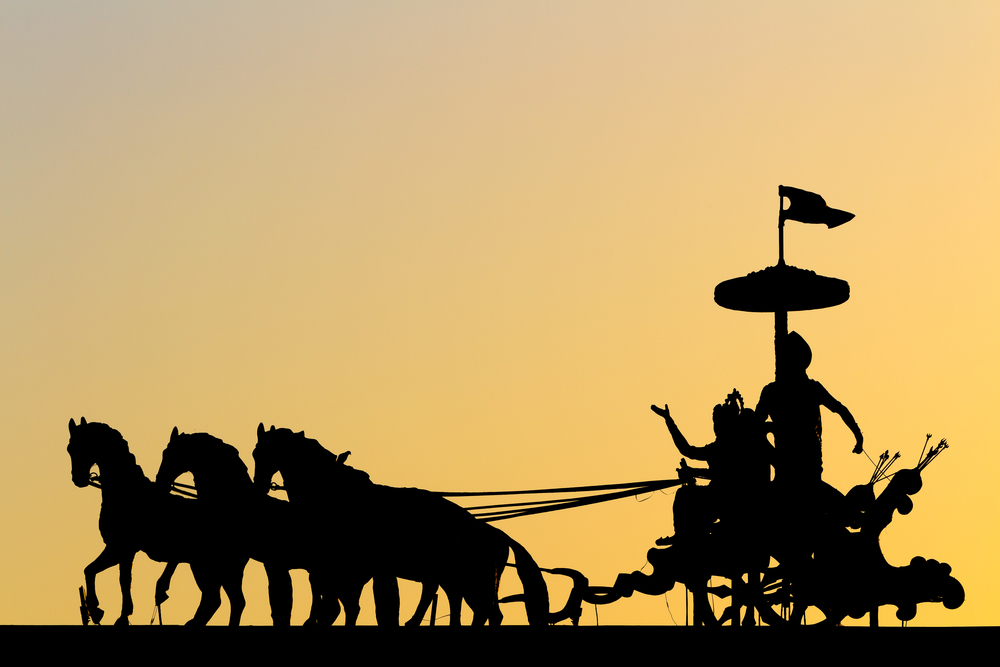The Bhagavad Gita presents itself to us as a historical event that took place in India a little over 7500 years ago, according to astronomical calculations from the text of the Mahabharata. That moment in history and the events that preceded it are described in a larger work called the Mahabharata, an epic poem of over 100,000 verses, written in the ancient and sacred language of Sanskrit. The plot of the story concerns a royal family that was divided by a quarrel over leadership of the kingdom. That political struggle culminated in a battle of epic proportions in which over three million soldiers were killed in eighteen days.
The two branches of this dynasty were the Kauravas, headed by the selfish and dark-minded Duryodhana, and the Pandavas, led by Arjuna and his four brothers who were known for their virtuous and dharmic behavior. The two branches of the family were first cousins, the children of two brothers. The Kauravas were descended from a blind king named Dhritarashtra, while the father of the five Pandavas was a valiant and honorable king named Pandu.
In the final analysis, the cause of the battle was twofold. First, Duryodhana was envious of his cousins’, the Pandavas, charisma and personal endowments, and so unjustly usurped their rightful half of the kingdom by coercion and force. Secondly and more important, he was by nature opposed to the view that creation is the manifestation of a divine will, intelligence, and purposefulness. Instead, he viewed the world as his personal property, meant for his own use and pleasure, without accountability to either the Supreme Being or the living beings under his control. The Pandavas were inclined to rule their kingdom as a sacred responsibility, with accountability to divine law and for the benefit of all living entities, whereas Duryodhana and his supporters were the classic tyrants with their abusive henchmen.
In the midst of this global struggle, a unique being was also present. The distinctive feature of India’s (Bharat’s) history and thought is the notion that from time to time, the Divine Intelligence or Supreme and Ultimate Being makes a personal appearance on Earth. The Sanskrit term for this process is avatar, which means a voluntary descent and appearance of the Ultimate Divine Being in a personal form, disguised as an ordinary human being. Thus, the Mahabharata claims that the Source of all existence, Bhagavan Shri Krishna, the Supreme Brahman Reality, Being and Person, appeared in India at this time as the cousin of both Duryodhana and his siblings, as well as Arjuna and his four brothers with their wife Draupadi.
An avatar is not a prophet, guru, teacher, angelic being, or “demi-god”. The avatar, unlike human beings, is neither forced to take birth nor born in ignorance, but rather, descends purposely in our midst at a specific, preplanned historical moment in order to make a revelation of the transcendental reality that exists beyond our sight. The other reason for the avatar’s coming is to adjust the affairs of humans, to restore balance to life on our planet, and to reaffirm and reveal the immortal truths that maintain all reality. Those truths are called Sanatana Dharma, that which is always true.
The Bhagavad Gita, meaning the Song of Bhagavan, was spoken on the battlefield where the armies of both sides had assembled for a final showdown. The Pandavas had spent the previous thirteen years in forced exile using diplomatic efforts to try to avoid an interfamilial conflict. When it was clear that the battle was inevitable, Arjuna went to Duryodhana one last time to ask him to cease hostilities and restore the peace. When the dark-minded king refused, Shri Krishna himself called one last meeting between Arjuna and Duryodhana, at which time He declared that, as the Supreme Being, he would not directly fight in the conflict. He proposed that one side receive his army and the other have Him as their advisor and chariot driver during the battle. Predictably, Arjuna chose Shri Krishna as his driver and charioteer, and Duryodhana was glad to have His army.
Soon thereafter, the two great armies assembled at a field called Kurukshetra. Kurukshetra is situated around 170 km north of what is now Delhi and is also known by many names like Brahmakshetra ‘Land of Brahma’, Uttaradevi, Brahmadevi, and Dharmakshetra ‘the place where dharma was tested’. It was on that field of conflict, just as the fighting was about to begin, that Shri Krishna spoke the message of the Bhagavad Gita to Arjuna, his best friend and cousin. Unlike Duryodhana, Arjuna was able to recognize that Bhagavan Shri Krishna was the Supreme Being appearing in the human world to renew and revive our understanding of timeless truths and to lend support in the fight against asuric forces on Earth.
Many layers of meaning…
The Bhagavad Gita has many levels of significance for us as readers. On one level, Shri Krishna is making an appearance here in the realm of matter to remind us that we are really immortal beings who come from the transcendental realm of Brahman and are only visiting this world of darkness and death.
On another level, Shri Krishna represents the all-pervading divine intelligence that is the creator, maintainer and destroyer of this material world. As such, Shri Krishna stands for and is the source of the invisible laws of nature to which all beings are accountable. In this role, Shri Krishna is advocating what we would now call ecology and sustainability, and Duryodhana represents the destructive and unsustainable attitude toward nature which promotes the view that no one designed or is in control of the material world.
At another level, the battle that was acted out as a historical event 7500 years ago, as described in the Mahabharata, continues in the form of global conflicts wherever sincere and caring people oppose the harmful and evil practices of the modern day Duryodhanas. None of us is entirely free or safe from the effects of these seemingly unstoppable conflicts.
On another level, our bodies are in a constant state of conflict as our immune system fights against the invading hordes of entities trying to destroy the balance within our bodies. In this case, Duryodhana and his cohorts are cancer cells, anaerobic death-inflicting soldiers who bring darkness, dysfunction and chaos into our balanced bodies.
Finally, on the level of our mind, the doubts that plague us, depress us, and lead us to despair are just as certainly the forces of evil who have overtaken the field of our manas ‘our mind and heart’, and would like to extinguish the light of our atma ‘our true immortal self’. The struggle for existence of the human race is an apt metaphor for our position in the midst of the forces that swirl around us in the world of matter. We are either humans having a divine experience, or immortal beings having a human experience. As we will see, Krishna is the great light and Supreme friend who is forever in support of our existence as immortal beings. Therefore, His advice to Arjuna on the battlefield of Kurukshetra is relevant to anyone struggling against the forces of darkness, chaos and destruction as long as the struggle for ultimate truth continues in this realm of matter and duality.
It is also important to remember that Bhagavan Shri Krishna has two purposes for appearing before us. One of these is to be the driver of the chariot of our body and guide us safely through the struggle of life. The second and ultimately most important is to attract us back to the divine transcendental Brahman realm that is our true and immortal home. In fact, Krishna means the most beautiful and attractive Being.
In that capacity, it is important to remember that even though He is the Supreme, Shri Krishna has purposely taken the humble and menial task of being Arjuna’s chariot driver. The reason for this humble posture is that in the Bhagavad Gita, the Supreme Being is not depicted as an angry, vengeful, judgmental or dangerous ‘God’. Quite the contrary—Shri Krishna presents himself as Arjuna’s very best friend, speaks with him in a sweet voice, smiling, and at the end of the book tells him kindly to do what he wants by using his free will. So in spite of the fact that the Gita appears to be a war story, it is in fact a love story—the story of love’s struggle to exist in this difficult and challenging world, and the story of how love exists for eternity and never ends.
…thus dear reader, the story begins.
It could be over 7500 years ago in India, or right now, anywhere in the world. Arjuna, like us, is reluctant to fight against his own family and friends for any reason, yet he finds that an implacable evil exists in his world, just as it does today.
He has been chosen by destiny to lead the fight against the forces that would destroy the innocent and harm the world. He is, nonetheless, profoundly saddened at the struggle, being at heart a gentle, peace-loving being. He is sick at heart at the thought of the fight to come. If you have ever been depressed or afraid of facing the struggle of life, you can understand Arjuna’s heart and mind.
And now…with the horses and elephants dressed for battle, bugles and conch shells sounding the battle cry, the blind king Dhritarashtra, father of Duryodhana, asks his servant Sanjaya, who has the power of remotely viewing the distant battlefield. “What is taking place on the battlefield of Kurukshetra, in the conflict between my sons and the Pandavas, headed by Arjuna?”



